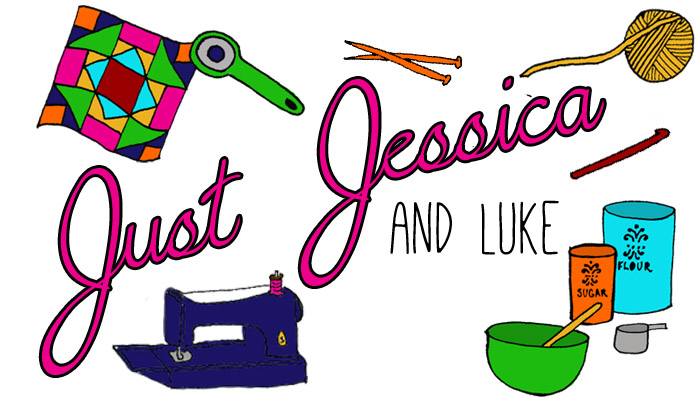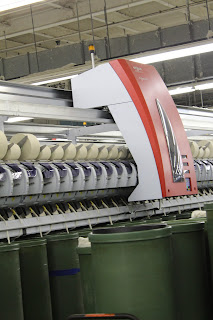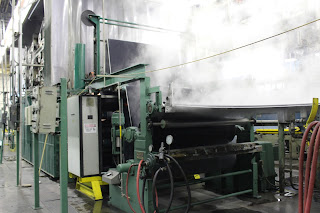The mill produces denim for companies we see everywhere including All American Clothing Company, and Denimatrix who distributes their denim to many other big name stores. My ears perked up because I've been thinking a lot about clothes and where they come from. This is a result of my friend Christa giving up her wardrobe for lent. (She's still wearing clothes, just limiting them to 9 items.) She is using this time to think about the labor behind our clothes and the side effects of "Fast Fashion." Our tour guides did say that most of their material is exported because of the cost of garment making in the United States. All of this was on my mind as we continued on our fabulous tour!
They start out blending all of the different grades of cotton to make more consistent yarn fibers.
At this point the cotton still has lots of pieces of dirt and plant in it.
The cotton is fed into this machine which blows it up and fluffs it while the heavier non cotton material is allowed to fall away from it.
Then it is fed into the carders.
It is filled with many wire bristles like a mega hair brush and comes all of the fibers until they are all aligned and going the same direction getting it in better condition for spinning! Same process as hand spinning just on a much bigger scale!
It is removed from the carder in this long tube of roving.
Look at that giant skein of mega yarn! Imagine making a blanket out of that scrumptiousness!
They then take 6 barrels of that freshly carded roving and ply it into another roving.This makes it more durable for the mechanical spinning. Because cotton is a shorter fiber it's trickier and more delicate to spin!
Here you can see all of the sections.
Then it is spun down into threads to weave into denim.
In some cases it is spun with spandex for stretchy jeans!
Remember all of those pictures in your history books of kids in factories changing spools of thread and tying together broken pieces of thread and yarn? Well this little machine replaces the void left by them when labor laws went into effect.
Different weights and styles of spins go on different colors of bobbins.
Then, they come along the track like guitar strings to be gathered up to be dyed.
They come together through this comb like tool and the fan blows the lint back away, all to keep the yarns from getting tangled.
They're bunched into an un-spun rope like this and then rolled onto a tractor tire size spool to be dyed.
These bundles are sent up into the air and back down into the indigo to be dyed.
The indigo needs "air time" for the color to gain intensity. This is why it comes out of the dye and then back in. In the picture below you can kind of see three different shades in the dying process.After they are dyed the right color they're rinsed and steam dried. In other words steam fills the barrels and makes them hot, and when the yarn passes over them it dries.
Now the yarns have to be re-separated so they can be more easily woven.
This man is taking about 5 at a time and sliding them into another comb like tool. There is a giant roller below the comb rolling them all onto the spool in an aligned format.
Then came the weaving process. It was happening so fast you could hardly see it!
The white threads with stretch were going horizontally and were getting trimmed off the edges as they were being rolled.
Ever get a pair of jeans and have them shrink on you? Or even worse, have the legs twist so the seam lies on the front of your leg instead of the side? This machine's job is to prevent all of that. Because the yarn is spun in one direction, there is a tool that un-twists the fabric!
This is a camera that scans the fabric for any defects. An inconsistent thread, a blemish in the weaving etc.It makes a map for the person who is cutting the bolts so they can cat the bolts without any blemishes in them. Here's a whole wall of examples of errors that came back. Anything from not untwisting enough to an irregular amount of acid in the dye or wash causing an extreme amount of distressing!
The final step that takes place here is the gentleman following the map produced by the camera and making large bolts to go to the jean manufacturers.
Look at all these tubes!!! Can you say boy heaven? They're light sabers, no they're swords, mines a lance!
It was a really cool experience! It's changed how I look at denim! Now if only they had a souvenir shop where you could buy a pair of jeans made from it!
Thanks Uncle Doc for setting that all up!







































2 comments:
Wow, that's very interesting! Great tour!
So cool. I love seeing the manufacturing process. One of our favorite tv shows around here is How It's Made.
Post a Comment